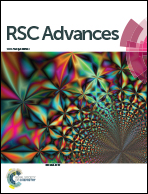Ultrasound irradiation for the green synthesis of chromenes using l-arginine-functionalized magnetic nanoparticles as a recyclable organocatalyst
Abstract
A practical, convenient, and cheap methodology is developed for the synthesis of a series of chromene derivatives via cyclocondensation of α- or β-naphthol, malononitrile and aromatic aldehydes, in the presence of L-arginine-immobilized magnetic nanoparticles, under ultrasound irradiation, in high yields. This catalyst can be easily separated from the reaction by an external magnet and recycled four times without its activity loss. This methodology has shown shorter reaction times when compared with conventional thermal heating.


 Please wait while we load your content...
Please wait while we load your content...